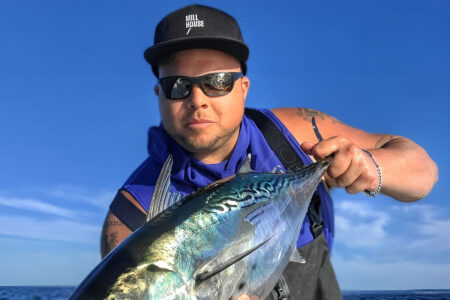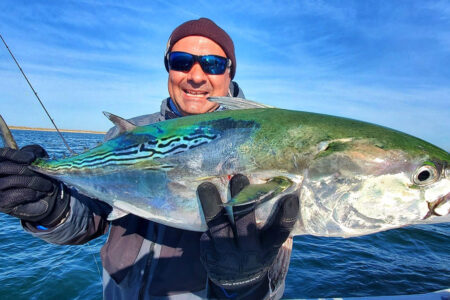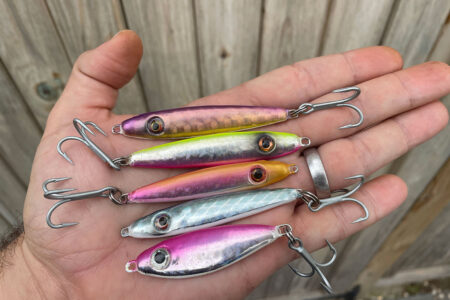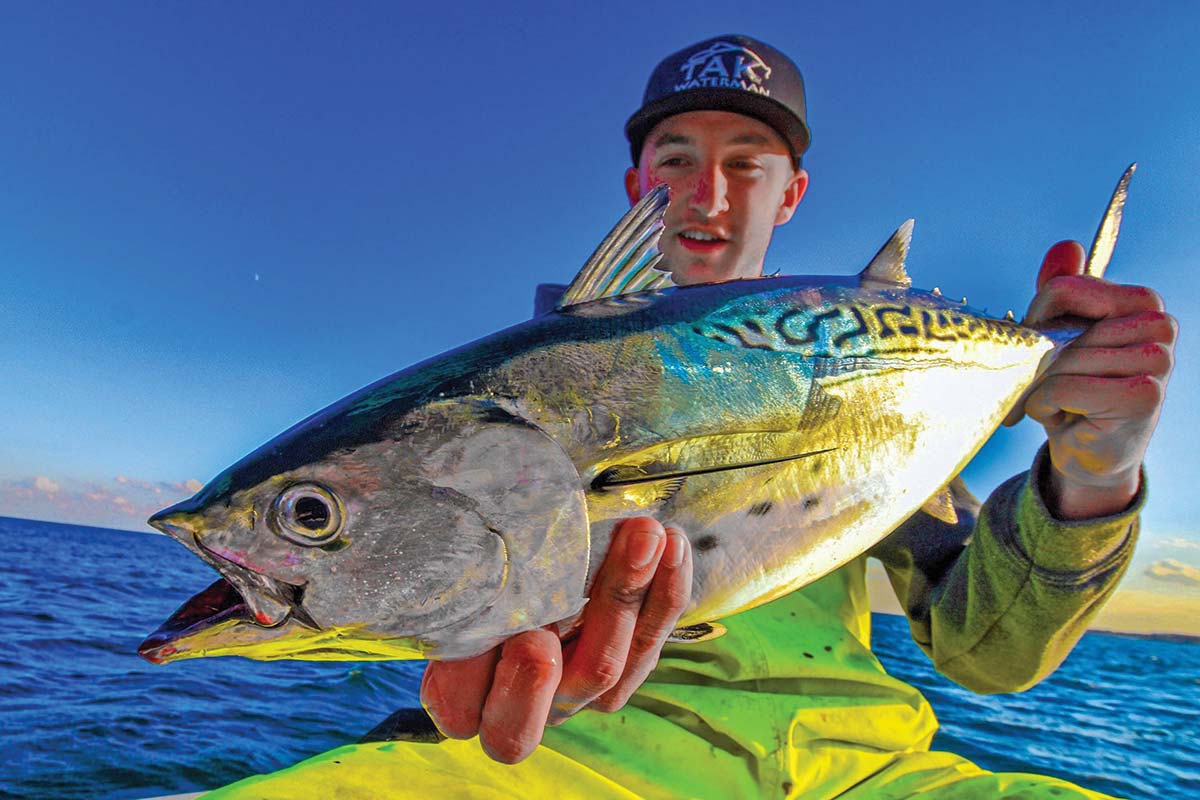
Hunting false albacore and related funny fish on the kayak is one of the greatest local inshore challenges and thrills.
What causes an increase in blood pressure, an elevated heart rate, sleep deprivation, a tendency for nonsensical mumbling and a resulting string of unplanned sick days from work? A new strain of the flu? The corona virus? Shingles? Nope, none of the above; these are but a few of the symptoms related to the annual onset of acute euthynnus alletteratus pyrexia, or as it’s more commonly known, Albie Fever.
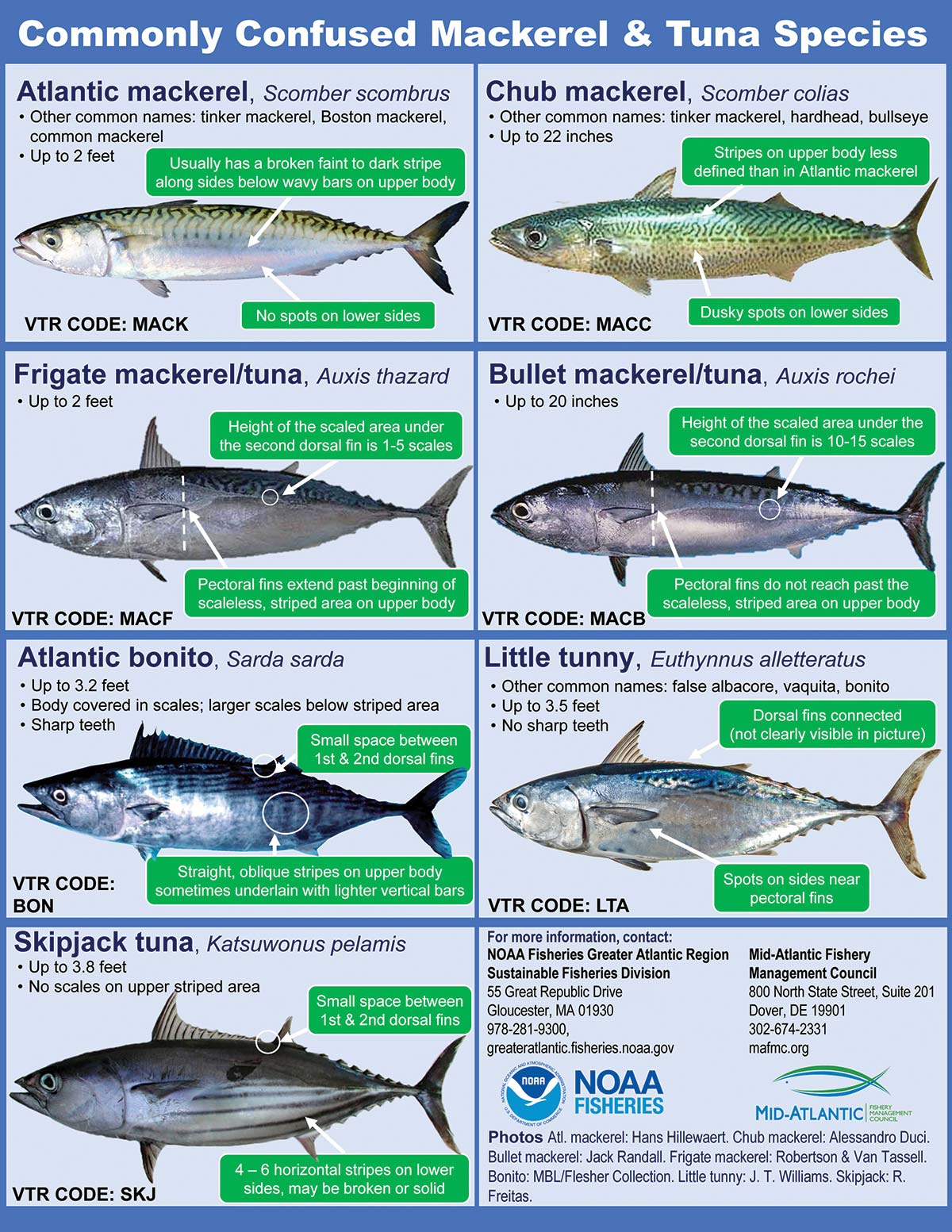
A quick visit to your social media platform of choice, or the local tackle shop, boat ramp or beachfront between the months of August and November, will likely uncover the unmistakable signs of the disease. Anglers from New England on through the Mid-Atlantic simply can’t get enough of the annual visit of pelagic species such as false albacore, bonito, Spanish mackerel, king mackerel and other various mackerel species to the inshore fishing grounds. But it’s the sometimes maddening tendencies of this group of fish, collectively referred to as hardtails, to show themselves in boiling blitzes yet refuse to take any artificials thrown their way which really drives anglers over the edge.
Much is made about making a stealthy approach when hunting inshore pelagics as a key in finding consistent success. How many times have you heard anglers complain about a pleasure boater seen blasting through a school of boiling fish, or worse yet, been there yourself when a fellow angler stricken with albie fever ran his boat directly into a school of working fish? Well, with the nearly silent nature of the kayak platform at least it won’t be you on the receiving end of scowls and threats of bodily harm from your fellow fishermen when a school is put down.
Kayaks provide both benefits and limitations when hunting easily spooked fish like the false albacore, and for the most part I will reference the albie in this article as that is what gets the most attention in my home waters. However, keep in mind that most of what is said here can be applied to whichever species of inshore speedsters is present in your waters right now.
Limitations
I’ll get the limitations out of the way first as I’m not here today to dissuade you from kayak life. First and foremost one’s speed and range is limited on a kayak when compared to that of a boat. A suitable launch site in close proximity to known feeding grounds must first be sought out, and from there the kayak angler must then pedal, paddle or—on new kayaks like the Old Town Sportsman AutoPilot—power their way to the fishing grounds. This puts the speed over water at just a few miles per hour to maybe 10 mph at best as opposed to 30, 40 or even 50-plus miles per hour which our boating friends can achieve. If fish pop up here, then blast off to a spot several hundred yards away over there, the boater can be on the school’s movements much faster.
Mobility can be both a blessing and a curse as I’ve seen a hot albie school boil off my bow only to sound and pop up in another spot before returning to the original spot of sighting inside a matter of seconds. Screaming around in a boat can give the fish a severe case of lockjaw. However, if the schools are on a speedy move, running in small pods, at times there is a necessity to chase the fish to stay on a bite. This is where a kayak angler must put more forethought into where they plan to fish, and I try to get in a good place to begin with on my kayak and fish in areas that hold bait and predators like coves and corners, or I set up in known feeding lanes like near outflows and channels between islands. In the former I wait for predators to pin bait in the pocket, while in the latter I am hunting moving fish as they seek out schools of baitfish passing through.
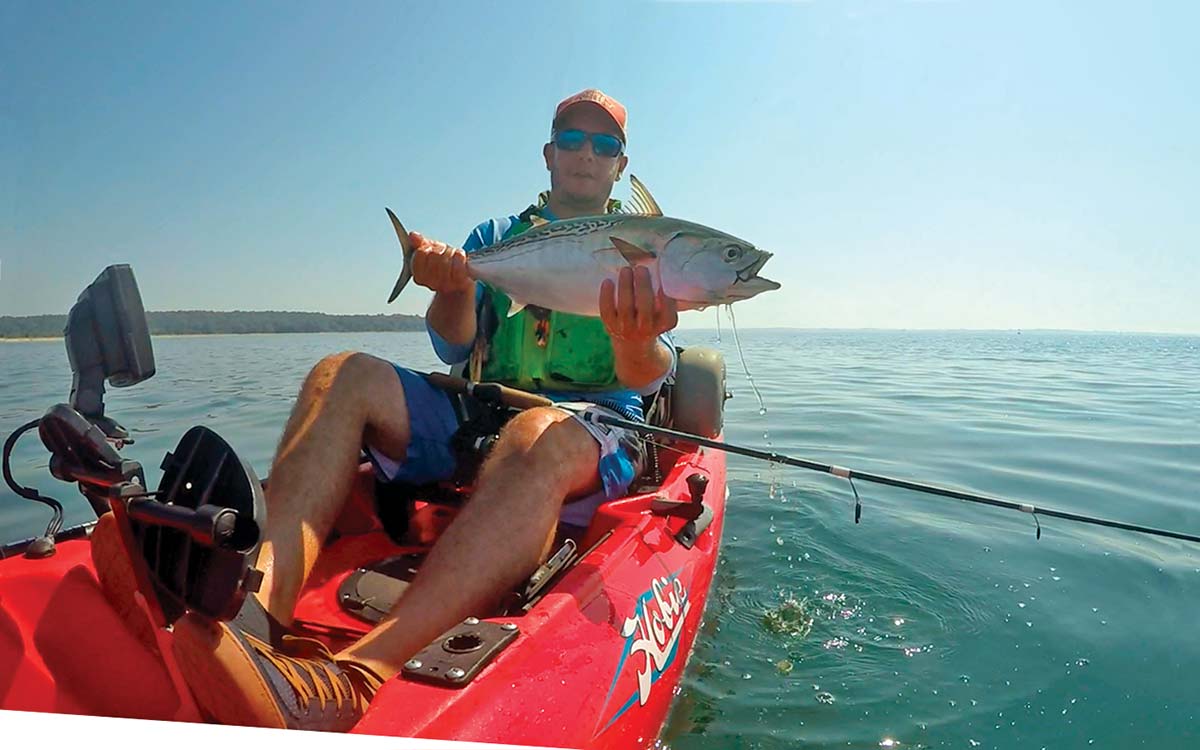
Benefits
Okay, now the benefit. As previously noted, the kayak is just about the stealthiest approach we have at our disposal when hunting albies, and this is first and foremost on the list of cases to be made in favor of the craft. Last fall I drifted over a mixed school of albies, striped bass and bluefish, and they were literally bumping the hull of my Old Town Predator PDL. The down and side imaging screens on my Humminbird Helix 9 was lit up on all sides as fish hammered small peanut bunker and silversides—it was an experience I am not soon to forget! Sure this could have happened while standing atop a fiberglass deck, and similar scenarios have unfolded for me in the past, but the fish didn’t mind my presence and the closeness to which the fish were feeding was amazing.
Gear for chasing funny fish from a kayak is not really much different than that of boaters, my only suggestion is to eliminate treble hooks anywhere possible. Sure this advice is good for the fish, but selfishly it’s even more so for the angler. Consider where an albie is going to be placed for hook removal while sitting in a kayak seat. The LAST place I want a treble hook connected to a rapidly-beating albie is anywhere near my lap! In place of treble hooks I use inline single hooks or just regular old single J-hooks whenever possible. As I’ve covered many times before, single hook scan be used on just about every plug out there with a solid, non-swivel hook hanger; you just need to experiment a little to confirm the proper size replacement.
The Right Tackle
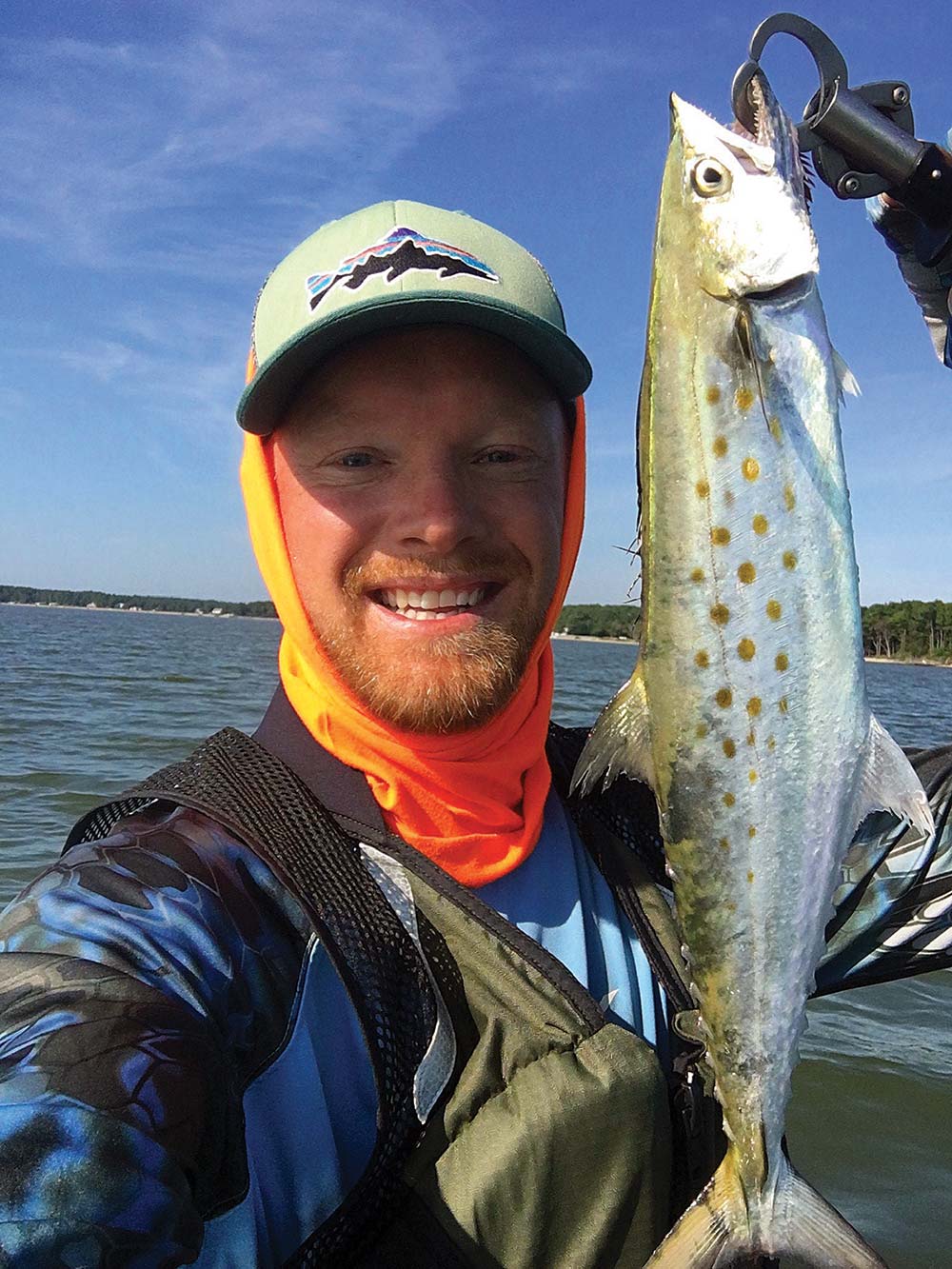
Rods in the 6- to 7.5- foot range with a light tip and some backbone are perfect for kayak fishing, and I usually carry a few rigged and ready for different scenarios and to be able to change lures at a moment’s notice. Popular rods include the G Loomis IMX-Pro 842S F and 843S F, Star Rods Stellar Lite SG817FT76G and SG12201SM, and the Tsunami Carbon Shield II TSCSHDII701M or TSCSHDII761M.
For reels you want something with a strong, reliable drag, and this is where in general I advise putting the majority of your speedster budget. Saltwater grade reels are pretty much standard issue, but some freshwater models will suffice; just be prepared to clean them regularly or expect to need to buy replacements as the combination of long, fast runs and constant saltwater splashing justifies quality equipment here. My favorite reels include the Shimano Stradic C5000XG, Tsunami Evict 3000, PENN Battle III 4000 and the Daiwa Saltiga BJ4000. Spool the reels up with 15- to 30-pound braid and top with appropriate leader material attached with a swivel, Alberto knot or my favorite, the FG knot. Most everyone targeting speedsters throws fluorocarbon leaders, and I keep spools of 12-, 20-, 25- and 30-pound test on hand with 20 being most commonly used for me. If bluefish or larger bass are mixed with the albies, which can happen quite often, I will increase leader strength. On days when the bite is tough and the fish are overly finicky, I drop down to 12.
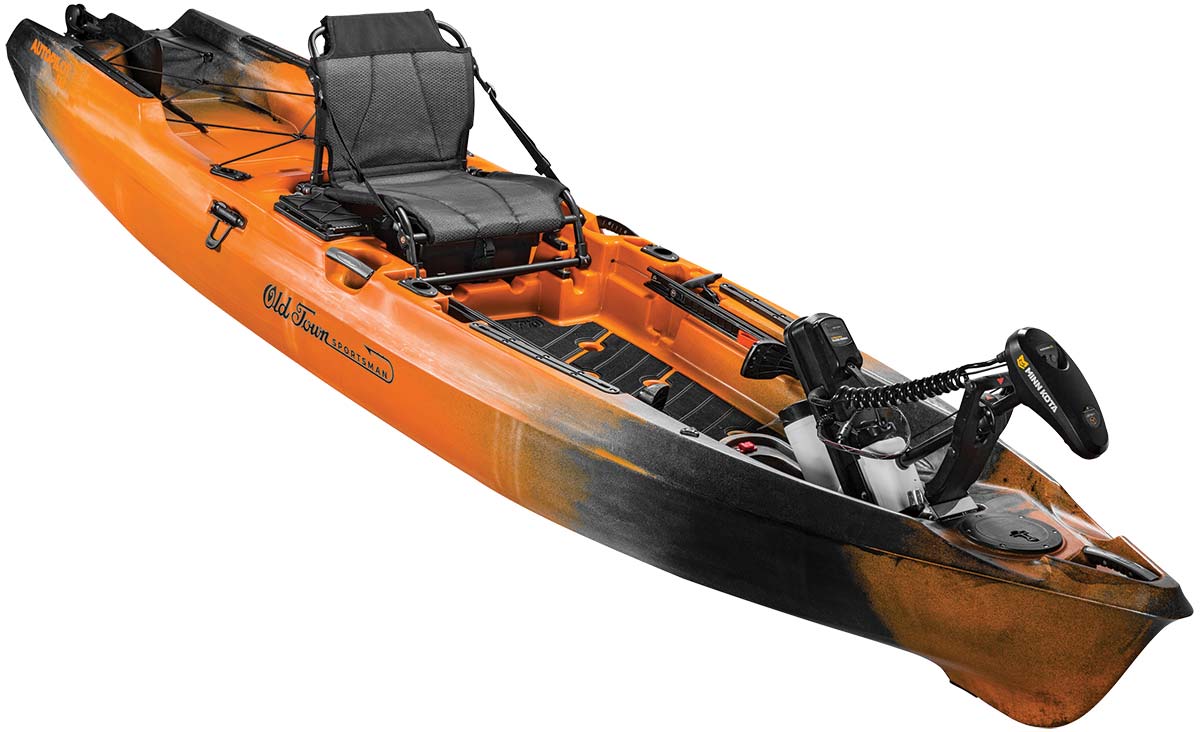
Earlier this year The Fisherman Magazine launched its first subscriber-only, multispecies, catch and release, season-long kayak fishing tournament, the Coastal Kayak Clash. This is your opportunity as a Fisherman Magazine subscriber to win a brand-new, fully tricked-out Old Town Sportsman Series Autopilot 136 kayak and many more awesome prizes! Among the eligible species is the combo ‘hardtail’ category which includes both false albacore and bonito, and with special ‘Fish of the Month’ designation the longest hardtail entered in September will earn the angler an additional prize. Please visit www.TheFisherman.com for complete details.
Regardless of my craft, I like to have at least three rods rigged and ready when hunting albies. One rod has a soft plastic like an Albie Snack or Tsunami Split Tail Minnow (my albie secret weapon!), another rod has a topwater spook like the Yo-Zuri Hydro Pencil or Rebel Jumpin’ Minnow, and the final rod has a metal or epoxy-type bait on it. When deeper-bodied baits like peanut bunker or butterfish are present, wider profiles like that of the Hopkins Shorty, Kastmaster or Point Jude Butterfish get thrown. If the bait du jour is long and slender like silversides, sand eels or bay anchovies, then I match the hatch by throwing JoeBaggs Tackle Resin Jigs, Hogy Epoxy Minnows, Game On! Exo Jigs or Tsunami Forktail Candy jigs. Another benefit of the tins/epoxy baits is that when the albie bite slows you can drop the jig to the bottom and see what might bite. I’ve landed fluke, porgies, black sea bass, striped bass, bluefish and even blackfish while killing time between blitzes.
My last note involves tying on your artificial of choice. Most anglers I speak with tie direct when hunting hardtails, and often times it’s suggested to use a loop knot to give the lure a little extra freedom of movement. However, and I’ve been testing this the last few years with no real ill effects, a small-yet-strong snap is a viable option and the idea that a snap is going to turn off a feeding fish may be overblown. Stay with me for a moment and consider the following example. Take your average epoxy-type jig and place it in your hand. It likely has a naked line tie on one end, and a split ring and treble or single hook on the other end. Now place a small clip on the front of that jig—the new Tactical Anglers ‘micro clip’ for example—and tell me which end looks less natural. While a case can be made that the clip on the nose of the lure isn’t likely to attract any fish, conversely I’d be hard-pressed to believe it is really going to turn away all that many bites at the end of the day with that obviously-unnatural hook hanging off the lure’s posterior.

